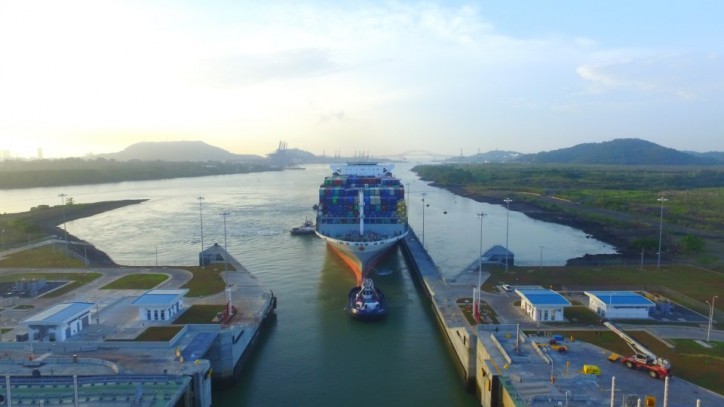Yesterday, less than a month after the previous record was set, the Panama Canal welcomed the Neopanamax container vessel OOCL France, making it the largest capacity vessel to transit the Expanded Canal since it was inaugurated in June 2016.

The OOCL France containership-which measures 366.47 meters in length and 48.23 meters in beam with 13,926 total TEU allowance (TTA)-transited northbound from the Pacific to the Atlantic Ocean.
"This trend towards the transit of 13,000 TEU or greater vessels demonstrates the acceptance and trust that the shipping industry has with the service provided by the Expanded Canal," Panama Canal Administrator Jorge L. Quijano said.
The previous record was set on May 2 by the COSCO Development containership, which measures 366.45 meters in length and 48.26 meters in beam and has a 13,345 TTA.
The OOCL France is deployed on the new OCEAN Alliance's weekly South Atlantic Express (SAX) service, connecting Asia-U.S. East Coast ports via the Panama Canal. The SAX service is comprised of 11 vessels ranging in size from 11,000 to 13,000 TEUs. OOCL France is the second vessel in this service to transit through the Expanded Canal after the COSCO Development earlier this month.
Environmental Efficiency Recognition
As this is OOCL France's first transit through the waterway, the Panama Canal honored the vessel with the Green Connection Award in recognition of its commitment to emissions reductions by using the Panama Canal route.
By using the waterway, this vessel helped reduce approximately 5,000 to 26,000 tons of carbon dioxide (CO2) in comparison to alternative routes.
Expanded Canal Performance
To date, a total of 1,360 Neopanamax vessels have transited the Expanded Canal since it first opened. Of this total, containerships have represented approximately 43.8 percent of traffic, followed by liquefied petroleum gas (LPG) carriers and liquefied natural gas (LNG) carriers, which represent approximately 29 and 8.1 percent, respectively.
About the Panama Canal Authority
The Panama Canal is run by an autonomous agency of the Government of Panama in charge of managing, operating and maintaining the Panama Canal. The operation of the Panama Canal Authority (ACP) is based on its organic law and the regulations approved by its Board of Directors.
About the Panama Canal Expansion
The Panama Canal Expansion is the largest enhancement project since the Canal's opening in 1914. Considered and analyzed for a decade with more than 100 studies, the Expanded Canal provides the world's shippers, retailers, manufacturers and consumers with greater shipping options, better maritime service, enhanced logistics and supply-chain reliability. The Expansion included the construction of a new set of locks on the Atlantic and Pacific sides of the waterway, creating a third lane of traffic and doubling the cargo capacity of the waterway. While the expanded locks are 70 feet wider and 18 feet deeper than those in the original Canal, they use less water due to water-savings basins that recycle 60 percent of the water used per transit. In line with its commitment to customer service, the Panama Canal will continue to provide the world with value for another century and beyond.
Source: Canal De Panama